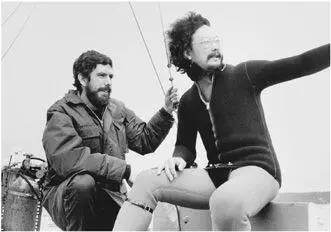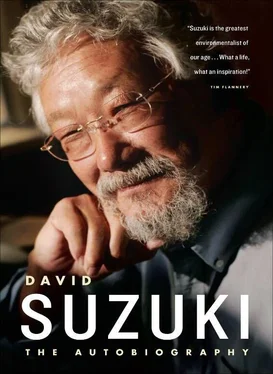We set up a stand-up on an island just offshore from Los Angeles, where the animals go to breed. Several huge males were lying on the beach, looking most benign. Rudi lined up a shot so that I could give my lines with the seals visible behind me. I delivered my lines, and Rudi said, “That was good, David. Now, would you mind backing up to get closer to the animals?”
The thing about camerapersons is that they are totally focused on what they see through their eyepiece. Often they seem completely unaware of the danger or discomfort others may feel. But I was up to the task. We had a usable stand-up “in the can,” so now we could try for a more impressive shot. We filmed another piece, which Rudi also pronounced fine, and then he had me move closer. My back was to the animals, but they didn't seem to mind, so I kept backing up. We did four or five takes.
I began my spiel once more, then realized that Rudi's free eye wasn't squinting as usual but was opening ever wider, staring at me. The nearest elephant seal was practically under my bottom, and I thought he or another must have woken up. In fact, a huge male had lifted his head and body to tower above me. I'm no Attenborough; I fluffed my lines and scrambled out of the way.
When we were filming for The Sacred Balance , a series of four one-hour shows, one of our first trips was to Pond Inlet on Baffin Island in the eastern Arctic. It was a wonderful time: the sun remained above the horizon twenty-four hours a day, and we often found ourselves filming at 10:00 PM with light streaming down on us. The ice was melting, and we were able to film hunters shooting a narwhal at the edge of the ice sheet.
One spectacular shot from a helicopter was to show me walking alone across an immense expanse of ice. All our gear and the crew had to be taken far away so they wouldn't be in the shot. Neville Ottey, the cameraman, was perched in a chopper that hovered above me for a while as I walked along, and then it pulled straight up until I became just a dot on the ice.
Before we took the shot, at the insistence of our Inuit guides I had carried a rifle, because polar bears are virtually invisible on the ice. They can jump up and attack so quickly and powerfully that I wouldn't have been able to get help before I was killed. That shoot is the only time I have felt the hair on my neck stand up; all of my senses were wide open as I walked along. I can't tell you how happy I was when Neville announced that he had the shot and we could leave.
More common hazards have arisen in urban areas. Once, for a film about magic and illusion, producer Daniel Zuckerbrot had a cute idea: we would start a stand-up with a “medium” shot from below of me on the strut of an airplane, wind blowing through my hair, propeller roaring, sky in the background. Next we would cut to a wide shot of the plane in the air with me outside it, then to a close-up of my face as I continued talking “to camera.” Finally, I would let go and drop out of the frame. In the following shot, we would reveal that I was standing on the strut of a plane that was still on the ground, with the propeller spinning; I had merely stepped onto the ground.
The sequence was edited together perfectly, and until the last shot it did indeed seem I had jumped out of a flying plane. But in order to get the sequence, I actually had to fly while being filmed from another plane. Yes, I had to get out onto the strut, talk to the camera on the other plane and hang on until the cameraman signaled he had the scene.
Even more hair-raising, I couldn't be tied or attached to the plane. I had to wear a parachute and be prepared to use it in case I fell. I was quickly instructed on how to pull the cord and release the chute. I had never jumped from a plane; somehow, a one-minute instruction that ended with “if you slip off, just pull this cord and you should be fine” was not that reassuring. Nevertheless, I did it, and for some reason I felt no fear when I got out onto that strut. Actually, I was half tempted to jump. I instructed the cameraman to keep shooting if I did fall. No point wasting the opportunity.
I think the most dangerous urban shoot was a stand-up for that same show on drugs. Vishnu said we had to do a stand-up in New York City to convey the flavor of a “drug neighborhood,” so I flew down to New York on a Saturday to meet the crew that night. We drove to the middle of Harlem and parked the van at the corner of Martin Luther King and Malcolm X streets. It's the only time I have ever felt white, as if my skin were shining like a beacon.
When we hauled out the camera and gear, a cluster of young black men formed around us. “What are you guys filming?” they asked. Perhaps Vishnu felt oblivious to the attention we were attracting, but I was scared. When he told them we were doing a film on drugs, the response was exasperated. “You mean you are going to do another film showing us bad-ass niggers doing drugs!” a young man exploded. A big fellow put his hand over the camera lens and told us: “You are not going to film a f--ing thing here.”
“Let's get the hell out of here, Vishnu,” I hissed, as he seemed about to argue with the group. Filming in that location seemed to me the most horrendously stupid idea I've ever been involved in, and I believed we were lucky to get out of there intact. So where do you think we ended up shooting the stand-up? On a street where all the buildings were boarded up because they were occupied by gangs of crack and heroin dealers. I did my piece under a streetlight with the dark, shuttered buildings behind me, expecting to feel a bullet in my back at any moment. And the CBC doesn't even give danger pay for a shoot like that.
A lot of the time, the danger seems real only in retrospect. When we are shooting, we are so intent on getting the piece in the can that any danger seems minor. For A Planet for the Taking , we filmed a sequence on a kibbutz in Israel near the Jordanian border at a time when Arab — Israeli hostilities had broken out. As we filmed, we could hear gunfire and the drone of planes along the border, but it was only after I had left Israel that I wondered how dangerous it might have been.
Another shoot was very plainly hazardous. It was a story about offshore oil drilling before the Hibernia oil field off Newfoundland had been fully developed. We dressed in survival suits and flew in a large helicopter far out over the ocean to an immense drilling platform where dozens of men lived. From there, a smaller helicopter lifted our gear in a sling and transferred two of us at a time, clinging to the outside of the net, to a barge where we would film the stand-up with the platform in the background.
As we soared into the air and over the water, I was confident in my ability to hold onto the netting, but I learned later that cameraman Neville Ottey was terrified on that ride. I am impressed with his courage, because in spite of his fear, he did the job. I realized how dangerous the whole operation was when we were being dropped onto the barge. It was rising and falling many feet at a time; at one moment we would be way above the deck and then suddenly, splat, right on it. It turned out to be a spectacular stand-up, with the barge surging up and down with glimpses of the oil rig behind me.

Preparing to dive for an underwater shoot near Halifax with unidentified scientist
from Dalhousie University
I have had many uncomfortable stand-ups, usually involving squeezing into spaces such as an astronaut's suit at the National Aeronautics and Space Administration center in Houston, Texas, or a hard-hat diving outfit for deepwater exploits. But two are particularly memorable for their unpleasantness.
Читать дальше



![David Jagusson - Devot & Anal [Hardcore BDSM]](/books/485905/david-jagusson-devot-anal-hardcore-bdsm-thumb.webp)









